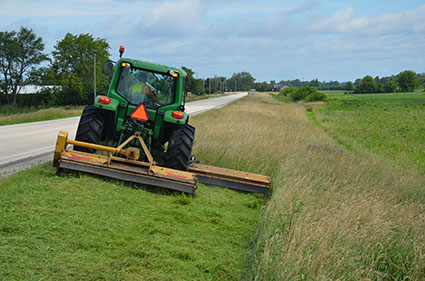Highway Maintenance |
Roadsides |
Mowing Wisconsin's roadsides |
Rural policy |
Urban policy
 WisDOT’s mowing strategies and policy strive to balance budgets, animal activity, invasive species and declining pollinators. WisDOT’s long-standing
natural roadsides mowing policy focuses on preventing the spread of invasive species and promoting the growth of native plants. This approach encourages minimal mowing and the preservation of native vegetation when possible. Mowing is completed by county highway crews.
WisDOT’s mowing strategies and policy strive to balance budgets, animal activity, invasive species and declining pollinators. WisDOT’s long-standing
natural roadsides mowing policy focuses on preventing the spread of invasive species and promoting the growth of native plants. This approach encourages minimal mowing and the preservation of native vegetation when possible. Mowing is completed by county highway crews.
Mowing goals:
- Support public safety, especially at intersections and curves
- Provide safe areas for vehicles to pull off roads in emergencies, and clear recovery zones for errant vehicles that leave the roadway
- Balance the need to manage invasive species with overall aesthetics and budgetary limitations
- Protect wildlife, preserve and encourage native wildflowers and grasses
- Preserve Wisconsin's natural beauty
Mowing references:
Trans 280, Roadside Vegetation Management, establishes uniform procedures to maintain, enhance and protect roadside vegetation and ecology (maintenance of trees, shrubs, grasses and forbs).
NR 40 Invasive Species Identification, Classification and Control. This is the Wisconsin Department of Natural Resources Administrative Code.
Contacts
Roadside mowing interactive map
WisDOT contracts with each county highway department to perform mowing activities on state highways. This map helps guide county mowing operators and informs the public of planned times, location, and types of mowing operations and vegetation management. The map also contains areas of vegetation identified as high value and environmentally sensitive. These areas have different mowing and vegetation management expectations.